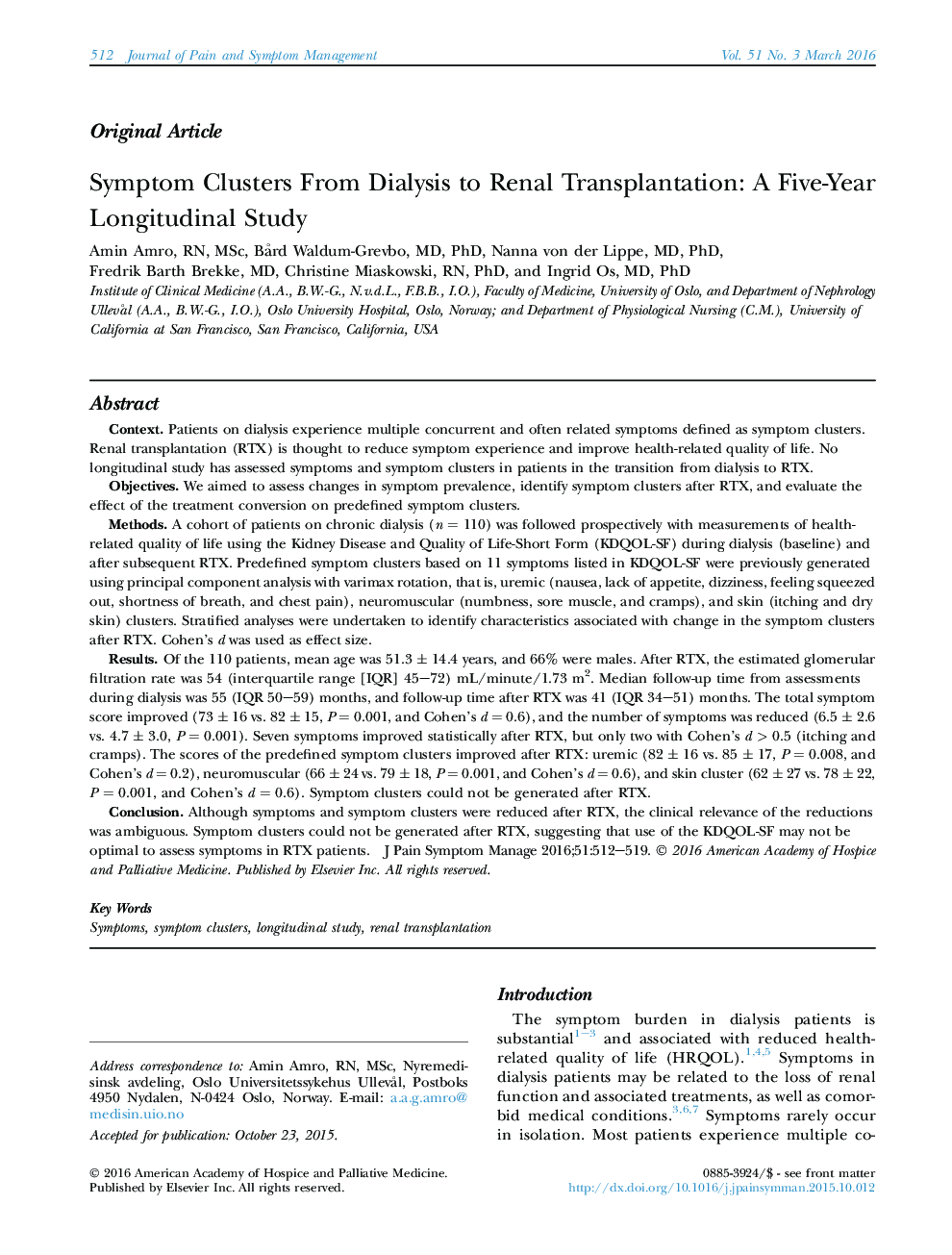| کد مقاله | کد نشریه | سال انتشار | مقاله انگلیسی | نسخه تمام متن |
|---|---|---|---|---|
| 2729728 | 1147155 | 2016 | 8 صفحه PDF | دانلود رایگان |
ContextPatients on dialysis experience multiple concurrent and often related symptoms defined as symptom clusters. Renal transplantation (RTX) is thought to reduce symptom experience and improve health-related quality of life. No longitudinal study has assessed symptoms and symptom clusters in patients in the transition from dialysis to RTX.ObjectivesWe aimed to assess changes in symptom prevalence, identify symptom clusters after RTX, and evaluate the effect of the treatment conversion on predefined symptom clusters.MethodsA cohort of patients on chronic dialysis (n = 110) was followed prospectively with measurements of health-related quality of life using the Kidney Disease and Quality of Life-Short Form (KDQOL-SF) during dialysis (baseline) and after subsequent RTX. Predefined symptom clusters based on 11 symptoms listed in KDQOL-SF were previously generated using principal component analysis with varimax rotation, that is, uremic (nausea, lack of appetite, dizziness, feeling squeezed out, shortness of breath, and chest pain), neuromuscular (numbness, sore muscle, and cramps), and skin (itching and dry skin) clusters. Stratified analyses were undertaken to identify characteristics associated with change in the symptom clusters after RTX. Cohen's d was used as effect size.ResultsOf the 110 patients, mean age was 51.3 ± 14.4 years, and 66% were males. After RTX, the estimated glomerular filtration rate was 54 (interquartile range [IQR] 45–72) mL/minute/1.73 m2. Median follow-up time from assessments during dialysis was 55 (IQR 50–59) months, and follow-up time after RTX was 41 (IQR 34–51) months. The total symptom score improved (73 ± 16 vs. 82 ± 15, P = 0.001, and Cohen's d = 0.6), and the number of symptoms was reduced (6.5 ± 2.6 vs. 4.7 ± 3.0, P = 0.001). Seven symptoms improved statistically after RTX, but only two with Cohen's d > 0.5 (itching and cramps). The scores of the predefined symptom clusters improved after RTX: uremic (82 ± 16 vs. 85 ± 17, P = 0.008, and Cohen's d = 0.2), neuromuscular (66 ± 24 vs. 79 ± 18, P = 0.001, and Cohen's d = 0.6), and skin cluster (62 ± 27 vs. 78 ± 22, P = 0.001, and Cohen's d = 0.6). Symptom clusters could not be generated after RTX.ConclusionAlthough symptoms and symptom clusters were reduced after RTX, the clinical relevance of the reductions was ambiguous. Symptom clusters could not be generated after RTX, suggesting that use of the KDQOL-SF may not be optimal to assess symptoms in RTX patients.
Journal: Journal of Pain and Symptom Management - Volume 51, Issue 3, March 2016, Pages 512–519
